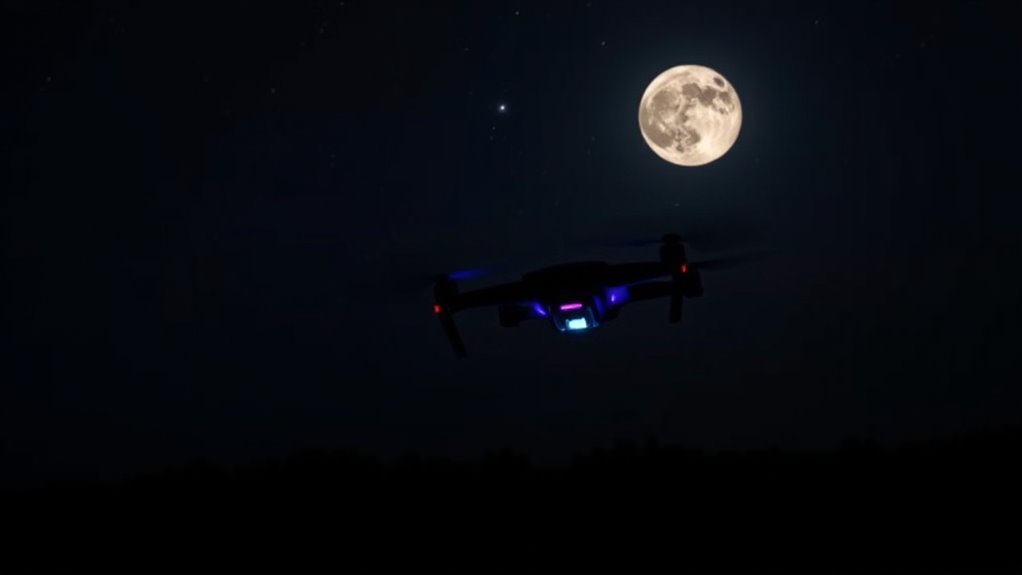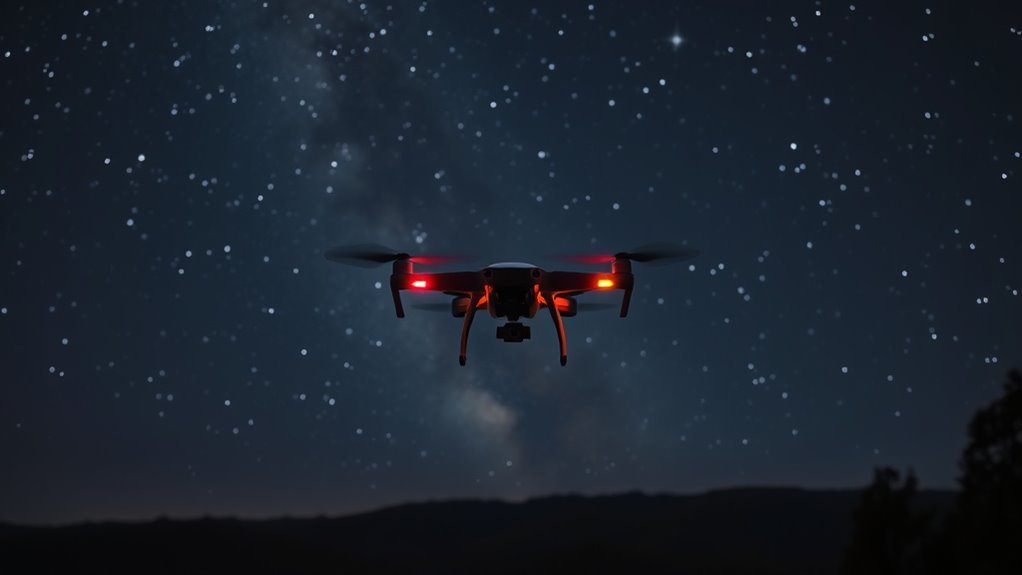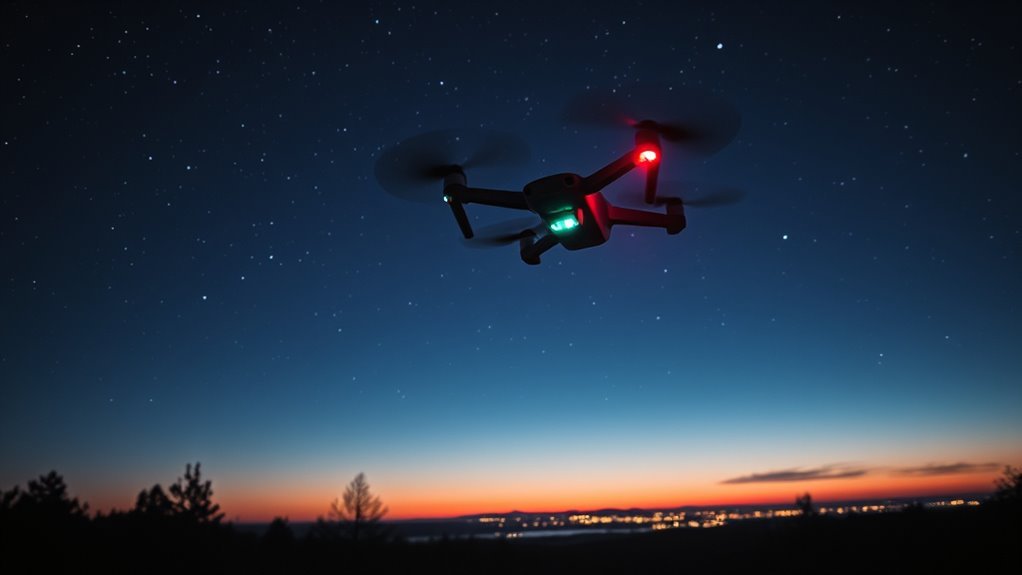To fly your drone recreationally at night, you need to know the legal requirements, such as maintaining visual line of sight and using proper lighting. Equip your drone with LED lights and guarantee its technical readiness before flying. Prioritize safety by choosing familiar areas to avoid obstacles and adhering to battery management practices. Understanding night vision capabilities will enhance your visuals. There’s much more to uncover about making your night flight enjoyable and compliant.
Understanding the Legal Requirements for Night Flying

Before you take to the skies with your drone at night, it’s vital to understand the legal requirements that govern nighttime flying. Night flight regulations are strict, guaranteeing safety for both you and others in the airspace. First, you’ll need to register your drone if it weighs over 0.55 pounds, and keep your registration up to date. Visibility is important; you must adhere to drone visibility requirements, which typically mandate that your drone has proper lighting—like anti-collision lights—to guarantee it can be seen from a distance. Additionally, flying within your line of sight is a must. Familiarize yourself with local laws, as they may vary, and always prioritize safety to enjoy the freedom of night flying responsibly. Moreover, be aware of restricted zones that may affect your operational limits during nighttime flights.
Equipment and Gear Essentials for Night Flights

When flying your drone at night, having the right equipment is essential for safety and compliance. You’ll need to guarantee your drone is equipped with the required lighting features to enhance visibility and avoid collisions. Additionally, considering extra safety gear can further protect your flight experience in low-light conditions.
Required Lighting Features
To guarantee a safe and successful night flight, you’ll need to equip your drone with the proper lighting features. Visibility is key, so consider these essentials:
- LED lights: Bright, efficient, and available in various colors, they enhance visibility and help you keep track of your drone.
- Flashing lights: These can signal your presence to other aircraft and improve safety.
- Glow sticks: Attaching these to your drone not only adds an extra layer of visibility but also creates an eye-catching display.
- Lightweight options: Choose lighting gear that won’t add much weight, so your drone remains agile and responsive.
With the right lighting, you’re set to enjoy the freedom of flying your drone under the stars.
Additional Safety Gear
Equipping your drone with the right lighting is just the beginning of ensuring a safe night flight. To enhance your safety, consider wearing reflective vests to improve visibility. Pack emergency flares in case of unexpected situations, and a first aid kit for minor injuries. Spare batteries are essential; you don’t want to cut your flight short due to power loss. Headlamps are invaluable for hands-free navigation, while portable chargers keep your devices powered. Don’t forget signal lights to communicate your position to others. Finally, noise reduction gear can help you maintain discretion while flying—ideal for late-night adventures. With this additional safety gear, you’ll enjoy a more secure and exhilarating flying experience under the stars.
Preparing Your Drone for Night Operation

Before you take to the night skies, it’s essential to guarantee your drone is properly outfitted for safe operation. This means checking your lighting setup, running through a thorough pre-flight checklist, and considering battery life to avoid mid-flight surprises. Let’s break down each of these key aspects to get your drone ready for nighttime adventures.
Lighting Requirements for Safety
Flying your drone at night presents unique challenges, primarily due to reduced visibility. To guarantee your safety and enhance night visibility, proper drone illumination is vital. Here are four essential lighting requirements for night operations:
- Anti-Collision Lights: Equip your drone with bright, visible anti-collision lights to avoid mid-air collisions.
- Navigation Lights: Use colored navigation lights (red and green) to indicate your drone’s direction.
- Landing Lights: Install landing lights to illuminate your landing area, making it easier to touch down safely.
- Strobe Lights: Consider adding strobe lights for increased visibility, particularly in darker environments.
Pre-Flight Checklist Essentials
Making sure your drone is ready for night operation involves a thorough pre-flight checklist that addresses both technical and safety aspects. Start with a detailed drone inspection to confirm all components are functioning correctly. Here’s a quick checklist to guide your pre-flight preparation:
| Aspect | Check |
|---|---|
| Lights | Ensure proper illumination |
| Camera & Sensors | Verify settings & clarity |
| Remote Control | Check signal strength |
Taking these steps not only guarantees peak performance but also gives you peace of mind as you embrace the freedom of night flying. With proper preparation, you can soar through the skies while keeping safety at the forefront of your adventure.
Battery Life Considerations
As you prepare for a night flight, understanding your drone’s battery life is essential for a successful operation. To guarantee you’re ready to soar, consider these battery optimization strategies and nighttime charging tips:
- Charge Before You Fly: Always charge your drone’s battery fully before heading out for a night flight.
- Use the Right Charger: Invest in a high-quality charger to promote quicker and safer charging.
- Monitor Battery Levels: Keep an eye on your battery percentage during flight to avoid unexpected landings.
- Store Batteries Properly: For extended periods, store your batteries at a 40-60% charge to maintain health.
With these practices, you’ll maximize your drone’s performance and enjoy the freedom of night flying!
Safety Precautions to Consider Before Flying at Night
While the thrill of night flying can be enticing, it’s crucial to prioritize safety precautions before taking to the skies. First, make sure your drone is equipped with proper lighting; this enhances visibility and helps you navigate potential hazards. Familiarize yourself with night vision capabilities, as they can assist in maintaining situational awareness despite visibility challenges. Always conduct a pre-flight check, confirming all systems are functioning correctly, especially the signal strength to ensure reliable communication during flight. Consider flying in familiar areas to reduce risks associated with obstacles and limited visibility. Finally, keep your distance from people and property to avoid accidents and respect privacy. By following these safety guidelines, you’ll enjoy the freedom of night flying while minimizing risks and guaranteeing a secure experience. Additionally, be aware of FAA regulations that may apply to night operations to ensure compliance and safety.
Choosing the Right Location for Night Drone Flying
Choosing the right location for night drone flying can greatly enhance your experience and safety. When location scouting, consider these key factors:
- Visibility: Make certain the area is well-lit or offers enchanting nighttime scenery, allowing your drone to be easily seen.
- Airspace Regulations: Check local laws and regulations, as some areas may restrict nighttime flights.
- Obstacle Awareness: Avoid locations with tall structures or dense trees that could impede your drone’s flight path.
- Safety Zones: Choose open spaces away from crowds to minimize risks and maximize your freedom to explore. Additionally, ensure that your drone is registered with the FAA, as this is essential for legal compliance during any flight, including nighttime operations.
Tips for Enhancing Nighttime Visuals With Your Drone
To capture stunning visuals at night with your drone, it’s essential to understand how low-light conditions affect your camera settings and flight techniques. Start by adjusting your ISO; a higher ISO can help you capture more light, but be cautious of noise. Use a slower shutter speed to enhance nighttime photography, but make sure your drone remains steady to avoid blurriness. Experiment with white balance settings to achieve the desired visual effects, and consider using a neutral density filter to control light exposure. Position your drone strategically to highlight interesting features in the landscape, utilizing city lights or natural elements. Additionally, the camera capabilities of your drone can significantly impact your nighttime photography quality. Finally, practice flying in various nighttime conditions to hone your skills and discover the best techniques for stunning nighttime visuals. Additionally, take advantage of the drone’s advanced camera capabilities to ensure high-quality footage even in challenging lighting situations.
Understanding Night Vision and Lighting Options
When flying your drone at night, understanding night vision technology and effective lighting options is essential for safety and performance. You’ll need to take into account how different lighting solutions can enhance visibility while adhering to regulations for nighttime operations. By mastering these elements, you can guarantee a successful night flight experience.
Importance of Night Vision
Although flying your drone at night can open up a world of creative possibilities, it also presents unique challenges that require a solid understanding of night vision and lighting options. Mastering night vision technology is essential for maximizing your drone’s night capabilities. Here are some key points to take into account:
- Sensor Quality: Make sure your drone has a high-quality camera equipped with night vision technology.
- Environmental Awareness: Be mindful of your surroundings; obstacles can be harder to spot in low light.
- Battery Life: Night flying can drain your battery faster; plan accordingly.
- Regulatory Compliance: Know local regulations about flying at night; confirm you’re compliant to avoid issues.
Embrace these considerations, and you’ll enhance your nighttime flying experience markedly!
Effective Lighting Solutions
Effective lighting solutions are essential for guaranteeing safe and successful nighttime drone flights. You can enhance your drone’s visibility using LED lights, which provide bright illumination and can be easily attached with custom mounts. Glow sticks are another viable option; they’re lightweight and can be secured with strapping solutions. Incorporating reflective tape on your drone offers additional visibility enhancements, allowing it to stand out in low-light conditions. Consider using color filters to create distinct visual effects while flying. Don’t forget to check battery indicators to guarantee your lights remain operational throughout your flight. By combining these lighting options, you’ll not only navigate the night safely but also enjoy the freedom of flying your drone after dark.
Regulations for Night Flying
Flying your drone at night requires understanding specific regulations that govern nighttime operations. To guarantee night flight safety, familiarize yourself with the following drone night regulations:
- Visual Line of Sight: Always keep your drone within your visual line of sight.
- Lighting Requirements: Equip your drone with proper lighting to indicate its position and orientation.
- Altitude Limits: Adhere to altitude restrictions set by local regulations to prevent accidents.
- Airspace Awareness: Be aware of any restricted airspace, especially near airports or other sensitive areas.
Navigating Obstacles and Airspace Regulations
As you prepare to fly your drone at night, understanding how to navigate obstacles and comply with airspace regulations is essential for a safe and successful flight. Keep in mind that obstacle awareness becomes even more vital after sunset. Utilize your drone’s lights and compatible apps to enhance your visibility and situational awareness. Additionally, consider the importance of obstacle avoidance systems as they can significantly improve your navigation capabilities in low-light conditions. Optimal battery life is also crucial for night flights, as it ensures that you have enough power for a safe return while navigating signal strength and potential obstructions.
Here’s a quick reference table to help you remember key aspects of airspace navigation:
| Obstacle | Awareness Tips | Airspace Regulations |
|---|---|---|
| Trees & Buildings | Use a map or app for planning | Stay below 400 feet |
| Power Lines | Maintain distance in flight paths | Know local airspace restrictions |
| Wildlife Areas | Avoid flying during sensitive hours | Check for no-fly zones |
With this knowledge, you’ll be more equipped to enjoy your night flights responsibly!
Best Practices for Managing Battery Life at Night
Once you’ve navigated obstacles and airspace regulations, managing your drone’s battery life at night becomes a top priority. Effective battery management is essential for maximizing drone efficiency during your night flights. Here are four best practices to help you:
Managing your drone’s battery life at night is crucial for maximizing efficiency during your flights.
- Charge Before Flight: Verify your batteries are fully charged before heading out.
- Monitor Battery Levels: Keep an eye on battery percentage throughout your flight to avoid surprises.
- Limit Flight Time: Plan shorter flights to prevent draining your battery too quickly in the dark.
- Use Night Mode: If available, activate night mode to reduce energy consumption while flying.
Additionally, understanding your drone’s battery capacity can help you better plan your flights and ensure you have enough power for safe operation.
Sharing Your Night Flight Experience With the Community
How do you share the thrill of your night flights with fellow drone enthusiasts? Start by capturing stunning footage of your night flight adventures—those mesmerizing aerial views under the stars. Utilize social media platforms like Instagram and YouTube to showcase your clips, engaging your audience with the magic of flying after dark. Join online forums and local drone clubs where community sharing is encouraged; sharing insights and experiences can foster learning and camaraderie. Don’t forget to participate in drone meetups or events, where you can demonstrate your skills in person. By connecting with others who share your passion, you’ll not only enhance your own flying experience but also contribute to a vibrant community that celebrates the freedom of night flight.
Frequently Asked Questions
Can I Fly My Drone at Night Without Special Permissions?
You can’t fly your drone at night without special permissions. Night regulations require additional safety measures. To guarantee compliance and safety, you should always check local laws and guidelines before taking to the skies after dark.
What Are the Best Apps for Planning Night Drone Flights?
When the night sky beckons, apps like DJI Fly and Litchi light your path. They offer drone mapping and flight tracking features, ensuring your nighttime adventures are as exhilarating as they are well-planned and safe.
How Can I Improve My Night Flying Skills?
To improve your night flying skills, practice using night vision techniques and refine your flight techniques. Familiarize yourself with your drone’s controls in low-light conditions, and gradually increase your confidence under the stars for ultimate freedom.
Are There Specific Drones Better Suited for Night Flying?
When you’re considering drones for night flying, look for models with night vision capabilities and enhanced light features. These will help you navigate better and capture stunning nighttime visuals, making your flying experience more exhilarating.
What Should I Do if My Drone Loses Signal at Night?
If your drone loses signal at night, initiate signal recovery procedures immediately. Use your drone’s night navigation features, retracing its last known path, while keeping an eye on the lights to locate it safely.

